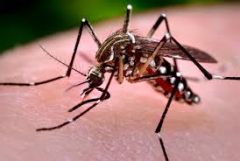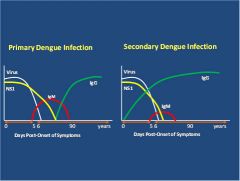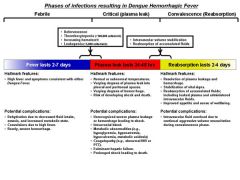![]()
![]()
![]()
Use LEFT and RIGHT arrow keys to navigate between flashcards;
Use UP and DOWN arrow keys to flip the card;
H to show hint;
A reads text to speech;
9 Cards in this Set
- Front
- Back
- 3rd side (hint)
|
How is Dengue virus transmitted? |
Aedes Egypti |

|
|
|
How many serotypes are there? What lab tests are used in dengue fever? |
4 serotypes, DEN1-4 PCR dengue viral RNA (day 2-3 of fever) NS1 antigen (day 2-3 of fever) Serology IgM (>day 5 of fever) Serology IgG (>2 weeks) |

|
|
|
What is the pathophysiology of dengue disease? |
Diffuse capillary leakage and abrupt increase in capillary permeability, leading to extravasation of plasma results in 3rd space losses, raised hemoconcentration and shock Thrombocytopenia also occurs |
|
|
|
What are the main symptoms of dengue fever? |
1. Fever lasting >3days (usually about 5-7 days) 2. Generalized symptoms: Myalgia, headache, retro-orbital pain 3. GIT symptoms: diarrhea, nausea 4. Non-specific rash 5. petechiae, purpura etc ** if there is fever >3 days, suspect dengue |
|
|
|
What are the 3 phases of dengue fever? Explain the phases |
1. Febrile phase (Febrile for 2-7 days) 2. Critical phase (Fever resolve, for 1-2 days) 3. Recovery/Covalescence phase (1-2 days) during febrile phase, there are the general symptoms of dengue as described above, and patient usually will not have significant bleed. during the critical phase, there is increased capillary permeability and leakage, thus higher chance of hypotension and lack of organ perfusion. DHF, DSS and DIVC may occur here. Monitor the patient closely for signs of shock etc Indicators suggesting that the patient is entering the Convalescent Phase include sense of improved well being reported by the patient, return of appetite, stabilizing vital signs, bradycardia, hematocrit levels returning to normal, increased urine output, and appearance of the characteristic Convalescence Rash of Dengue |

|
|
|
How should the patient be monitored in the critical phase? what symptoms are predictive of dengue shock syndrome? |
Look out for the 4 cardinal features of DHF: - Fever lasting 2-7 days - Thrombocytopenia <100 - Hematocrit rise by >20% - Positive torniquet test or spontaneous bleeding *** DHF may lead to circulatory failure, DSS In addition, monitor for signs of shock (DSS) - HR - BP - SpO2 - Urine output - capillary refill time symptoms predicting DSS: - severe abdominal pain - sudden change to hypothermia - tender hepatomegaly - sweating - persistent vomiting - restlessness or lerhargy |
|
|
|
What is the supportive management for dengue fever? How to manage DHF? How to manage DSS? |
1. treat fever and myalgia with acetaminophen, AVOID nsaids and aspirin, as they lead to further risk of bleed, and reye's syndrome in kids 2. Fluid replacement and correction of electrolytes 3. Monitor FBC, RP, LFT, PT/PTT 4. stop IV fluid once the patient is able to tolerate oral fluids, feels better, and has normal vitals/FBC. DHF: aggressive lactated Ringer's solution, plus serial FBC, BP, urine output. Give platelet transfusion if significant bleed occurs. (do not give platelet transfusion based on platelet levels) DSS: Aggressive fluid resuscitation. Switch to blood transfusion if loss is >10% or if refractory to fluid resus. |
|
|
|
When must dengue patients be admitted? |
- very young, very old, immunocompromised, multiple co-morbid - platelets <50 - significant dehydration - high haematocrit >50% - clinical bleeding tendency - acute worsening of platelets/hematocrit by >20% in 24 hours * if platelet is 80-140, can monitor outpatient, but must do serial FBC till platelets normalize |
|
|
|
Differentials of dengue fever? |
- chikugunya - japanese encephalitis - malaria |
|

